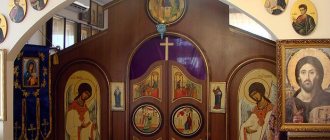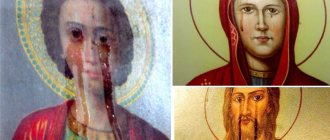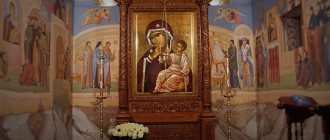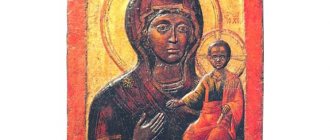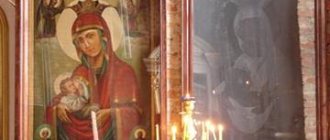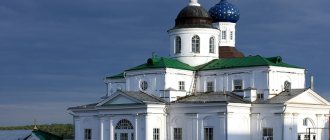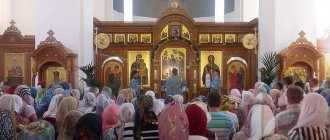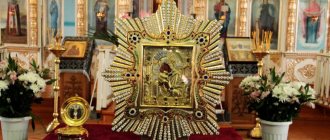Image and compositional features of the holy image
The main theological idea for the image was the theme of the coming of Christ, who became the incarnation of the Lord himself on Earth, for the sake of the salvation of every human soul. The board depicts the Mother of God holding the Christ Child in her hands. The fragile baby is the embodiment of the Heavenly King, who is coming to judge this world and every person.
A characteristic feature of this image is the unique placement of the hand of the Mother of God - she raised her right hand as if pointing people to Christ, telling whom they should worship and pray. It can also be interpreted as a personal appeal of the Mother of God to Jesus.
Researcher Kondakov argued that this image is the oldest of all that have reached the modern church. Initially it was known in Palestine, and after the 6th century it spread widely and became known throughout Byzantium and the East.
The composition of the iconography is very interesting:
- All characters are depicted frontally so that their faces do not touch each other. They seem to be detached;
- The person praying can clearly see the face of Jesus and His Mother;
- The face of the Virgin Mary is slightly inclined towards the child;
- The right hand is raised to chest level, where it is frozen, in a prayer gesture;
- Jesus is positioned in his arms;
- Christ's right hand blesses, and in his left there is a parchment (in some variations he holds a book instead of a whistle);
- The Queen of Heaven is depicted from the waist up, but in the world there are variants of the board where she is depicted in full height or, on the contrary, only up to the shoulders;
- On some similar icons the Child is located on the right side.
There is no exact information about how exactly the Smolensk Icon of the Mother of God came to the territory of Rus', however, since its appearance, the board has been revered and considered a precious shrine by all members of the Orthodox Church. Few Orthodox Christians did not know this image and did not pray to it.
Temples dedicated to the image of Hodegetria
Having considered the question: “Hodegetria - what is it?” — it should be noted that other shrines also correspond to this image. For example, in many cities both in Russia and other countries, there are temples that were built in honor of the image of the “Guide”. Let's look at the list:
- church in Kimzha, located in the Arkhangelsk region (not active);
- church in the city of Disna, Belarus (operating);
- chapel-temple of Hodegetria, it is located in Simferopol, Crimea (operating);
- Church in Kasimov, located in the Ryazan region (operating).
And there are quite a large number of such churches, chapels and temples, since the veneration of the Mother of God by the Orthodox is great.
History of the image
The author of the board, according to church tradition, is the Apostle Luke, whose gospel can be found in the New Testament. The board was discovered and transported to Constantinople from Palestine in the 5th century as part of other shrines by Empress Eudokia, whose husband was Emperor Theodosius the Younger.
According to surviving sources, it can be calculated that the board was initially kept in the Odigon convent, and on Easter days it was moved to the imperial palace. The monastery was already famous for its miracles at that time and was called Odigon or “Guide”, and later the shrine kept in it began to be called “Hodegetria”.
Important! The name “Hodegetria” perfectly suits the board not only in the place of its original storage, but also in the spiritual sense, because the Mother of God is the guide of all people to the Lord, who guides them to the truth and saves them from enemies. This portrait became one of the main ones in Constantinople - it was the one that was raised on the city walls during a siege, protecting the city from enemies.
Many historians confirm that this particular board became the main one in the procession. The miracle that occurred during this move is also known: according to the records of Stefan of Novgorod, who was a pilgrim in Constantinople, the picture of the Mother of God was carried through the streets and squares, but the miracle was that the heavy image was in a beautiful wooden frame, weighing at least 10-20 kg was worn by only one person throughout the entire course, which lasted about 4-6 hours. Isn't this a miracle?
More about miracles in Orthodoxy:
- Miracles and help of the Mother of God
- Barnaul miracle of Claudia Ustyuzhanina
- Lanchang Miracle
In the 11th century, the Mother of God Hodegetria entered the territory of Rus' as part of the dowry that Emperor Constantine gave for his daughter Anna during the wedding with Prince Vsevolod. When Vsevolod died, his son Vladimir Monomakh ordered the foundation of the Church of the Assumption of the Virgin Mary in Smolensk, where the holy inheritance was located. After this, Lik became the defender of the city. The first significant miracle occurred in 1239 during the siege by the army of Batu Khan. The warrior Mercury prayed to Hodegetria for a long time and received a revelation - to fight the enemy alone. According to the testimony of many Mongols, during the battle of Mercury there were angels and the Mother of God herself who fought with him. The Mongols fled, horrified by what they saw, and Mercury died there and became one of the saints of the Orthodox Church.
Hodegetria - what is it?
Where did this image come from? According to legend, it was originally written by the Apostle Luke during the life of the Mother of God. This image, which later became known as the Mother of God Hodegetria, was sent to Constantinople in the fifth century. For a long time he was in the Odegon monastery. Some researchers believe that this icon was a copy from Blachernae. That first image also contained a small part of the Mother of God’s maphoria.
Today, the Tretyakov Gallery houses one of the oldest such images, which remains as it was before. This icon originates from Pskov and dates back to the end of the 13th century. Previously, it was located in the Church of St. Nicholas of Kozh.
It should be noted that the name of this image has its own legend. According to it, the Mother of God appeared before two blind men and in some incomprehensible way led them to the temple in Blachernae. She placed the sufferers in front of the icon of the same name, and they began to see clearly. Since then, this image has received the name “Hodegetria”, which is translated from Greek as “guidebook”.
According to another legend, the icon became a blessing for the wedding of Anna, who was the daughter of the Greek emperor Constantine Porphyrogenitus. After a long journey to Rus', it acquired its name.
Where can you see the icon
At the beginning of the 15th century, the icon of Our Lady Hodegetria was moved to Moscow . The exact cause is unknown, but there are three versions of this event:
- Dynastic marriage of a Lithuanian princess and the Prince of Moscow;
- The inheritance of the last prince Yuri Svyatoslavovich, who was expelled by Vytautas and took everything with him;
- As part of the loot of Yurga, when he left Prince Svidrigail and went to serve the Moscow Prince Vasily Vasilyevich.
During his stay in Moscow, several copies were written from the holy face. In 1456, the original image returned to Smolensk, after the Moscow prince Vasily the Dark returned it as a future reunification of the two cities. At the same time, a copy was written and left in Moscow in the Annunciation Cathedral. On the copy, the infant Christ is positioned vertically, and researchers are inclined to think that this is how Jesus was depicted in the original Byzantine image. Later, the Mother of God of Smolensk was brought to Moscow several times to perform prayer.
The day of the Battle of Borodino was especially significant, when many holy faces, including Smolensk, were gathered in the Muscovites' religious procession. During the war with the French, the face was transferred to storage in the city of Yaroslavl for preservation and protection.
Important! In 1941, the Hodegetria, which was brought from Byzantium, was lost and it is suspected that it was stolen. A copy of the image is now kept in the Armory Chamber, where it came from the Novodevichy Convent, built in 1523. They did this for safety reasons, because the frame of the board is decorated with a rich gold frame and a pearl chasuble.
Other famous icons of this type
The Hodegetria of Smolensk icon is, of course, the most famous among others of this type. However, there are many others similar to it. One of these icons is the Georgian one. Initially, it was in Georgia, but after 1622 it was taken to Persia (after the conquest of the country by Shah Abbas). Her journey was long, and it stopped in the Arkhangelsk province at the Krasnogorsk monastery. Today, the original image is lost, but there are copies of it. Prayers are offered in front of the icon for the sake of deliverance from various epidemics, as well as to be cured of ear and eye diseases.
Another, no less important, icon depicting the Mother of God Hodegetria is the Iverskaya. This image has an equally mysterious history. In the 9th century, she was in the house of a pious woman. It was an iconoclastic period, and she decided to save the icon from destruction by lowering it into the waters of the sea. The icon appeared only two centuries later near Mount Athos near the Iveron Monastery. A gate church was built for her, where the image is still preserved.
Of course, these are not all the images of this type, which are kept and revered in many monasteries and temples. There are quite a few of them, and they all have their own special powers and provide protection.
What does Hodegetria help with?
Our Lady of Smolensk often moved, being located either in the churches of Moscow or in the cathedrals of Yaroslavl, and only in 1655 was she returned to Smolensk, where today you can bow and pray to her, the rights are no longer to the original image, but to a copy. Initially, the holy image was placed in Constantinople, which was saved many times by her. After all, it was before Hodegetria that many believers prayed for peace in the city and for an end to hostilities. She guarded first Byzantium, and now Russia, protecting it from military operations, destructive natural phenomena and terrible epidemics.
What do Orthodox Christians pray for before this image? They believe that the face:
- will protect the native land from hostilities and bloodshed;
- will protect those who are in the army and at the front;
- protects against diseases and epidemics;
- will protect every family;
- will patronize family people.
What else can you pray to the Mother of God for:
- Prayer before the icon “Softening Evil Hearts” for reconciliation
- Prayer before the icon “Inexhaustible Chalice” against drunkenness
- Prayer before the icon “The Queen of All” to get rid of cancer
This image represents a symbol of protection from harm and a symbol of health. They pray to the icon for the salvation of the family, for the protection of loved ones and relatives, for those who are far from their home. Those who go on a journey or business trip also ask for the protection of the Mother of God. The mother asks for the protection of the children, and the children ask for the health of their parents.
SMOLENSK ICON OF THE MOTHER OF GOD, CALLED “HODEGETRIA”
Special attitude towards the Mother of God in Rus'
So, the Hodegetria icon in Rus' is quite popular and very revered. Evidence of this is the numerous lists of the first image that spread throughout Ancient Rus'. It should be noted that the Mother of God is favorable to people living in this territory, since in many areas she is considered a patroness and intercessor.
Very often, sincere prayer saved a person from some misfortune or misfortune. There is a lot of evidence of this, both in ancient times and today.
What do they pray to the icon for?
The prayer to the Smolensk Icon of the Mother of God has been revered by many Christians for many centuries and helps incredible miracles happen. Smolensk “Hodegetria” is considered the patroness of travelers; they ask her to protect them from unpleasant situations, various diseases, and unforeseen troubles along the way. All those who suffer also pray to her, asking her to protect and preserve their home from ill-wishers and enemies. Throughout history, Christians have asked for help from the Smolensk Mother of God in times of severe mass epidemics.
Prayers before the Smolensk Icon of the Mother of God
Troparion, tone 4
We are now diligent to the Mother of God, / sinners and humility, and let us fall, / calling in repentance from the depths of our souls: / Lady, help, who have had mercy on us, / struggling, we are perishing from many sins ,/ do not turn away your slaves, // you and the one hope of the imams.
Translation: Now we, sinners and humble ones, will diligently run to the Mother of God, and we will fall to Her, crying out in repentance from the depths of our souls: “Mistress, help, take pity on us, hurry up, we are perishing from many sins! Do not let Your servants go empty-handed, for in You we have our only hope!”
Kontakion, tone 6
The representation of Christians is unshameful, / intercession to the Creator is immutable, / do not despise the voices of sinful prayers, / but advance, like the Good One, to the aid of us, / faithfully calling to You: / hasten to prayer and labor come to supplication, // interceding ever since, the Mother of God, who honor Cha.
Translation: The protection of Christians is reliable, Intercession to the Creator is unchangeable! Do not despise the prayerful voices of sinners, but come quickly, as the Good One, to the aid of us who call upon You with faith: “Hasten with your intercession and hasten your prayer, Mother of God, always protecting those who honor You!”
Kontakion, tone 6
We are not the imams of other help, / are not the imams of other hope, / do You, O Lady, / help us, / we hope in you / and we boast in you, / for we are your servants, / / let us not be ashamed.
Translation: We have no other help, we have no other hope, except You, Lady. Help us: we hope in You and boast in You, for we are Your servants; let us not be ashamed!
First prayer
To whom shall I cry, Lady? To whom shall I turn in my grief, if not to You, Queen of Heaven? Who will hear my cry and receive my sighs, if not You, Most Immaculate, the Hope of Christians and the Refuge for us sinners? Who will protect them more than You in misfortune? Hear my groaning and incline Your ear to me, the Lady and Mother of my God. Do not despise the one who seeks Your help and do not reject me, a sinner, Queen of Heaven! Teach me to do the will of Your Son and grant me the desire to always follow His holy commandments. For my murmur in illnesses, labors and misfortunes, do not retreat from me, but be the Mother and Patroness of the less cowardly, my Most Gracious Queen, Zealous Intercessor! Through your intercession, cover my sins, protect from visible and invisible enemies, soften the hearts of those at war against me and warm them with Christ’s love. Grant to me, who is weak, Your all-powerful help to overcome my sinful habits, so that, cleansed by repentance and subsequent virtuous life, I may spend the rest of my days on earth in communion with the Holy Church. th journey. Stand before me, Hope of all Christians, at the hour of my death and strengthen my faith in the difficult hour of death. Offer up your all-powerful prayers for me, who have sinned many times in this life, after my departure, that the Lord will justify me and make me a partaker of His endless joys. Amen.
Second prayer
To whom shall I cry, Lady? To whom shall I turn in my grief, if not to You, Lady Lady Theotokos, Queen of Heaven? Who will accept my cry and my sighing, if not You, O Most Immaculate One, Hope of Christians and Refuge for sinners? Incline, O Most Pure Lady, Your ear to my prayer, Mother of my God, do not despise me, requiring Your help, hear my groaning and inspire the cry of my heart, O Lord aka the Mother of God Queen. And grant me spiritual joy, strengthen me, who is impatient, sad and careless towards Your praise. Understand and teach me how it is fitting for You to pray, and do not depart from me, Mother of my God, for my grumbling and impatience, but be my protection and intercession in my life and bring me to the quiet haven of blessed peace, and count me to your face Your chosen flock and there deign me to glorify and glorify You forever. Amen.
Prayer three
Oh, Most Wonderful and Above All Creatures, Queen Theotokos, Mother of the Heavenly King Christ our God, Most Pure Hodegetria Mary! Hear us sinners and unworthy at this hour, praying and falling before Your Most Pure Image with tears and tenderly saying: deliver us from the pit of passions, O Most Blessed Lady, hut protect us from all sorrow and sorrow, protect us from all misfortune and evil slander, and from the unrighteous and the fierce slander of the enemy. Thou mayest, O our Blessed Mother, save Thy people from all evil and provide and save Thy people with all good deeds; Are there other Representatives for You in troubles and circumstances, and warm Intercessors for us sinners, not imams? Pray, Most Holy Lady, Your Son Christ our God, that He will honor us with the Kingdom of Heaven; For this reason, we always glorify You, as the Author of our salvation, and we exalt the holy and magnificent name of the Father and the Son and the Holy Spirit, in the Trinity we glorify and worship God, forever and ever. . Amen.
( 5 ratings, average: 4.60 out of 5)
Days of veneration of the holy image of the Virgin Mary
This happens three times a year:
- August 10 (July 28, old style). It was designated in 1525. It was on this day that the face was transferred from the Moscow Kremlin to the Novodevichy Convent. This monastery was founded by Vasily III, in gratitude to the Mother of God for the miraculous deliverance of the city from the Lithuanian invaders.
- November 18 (November 5, old style) was appointed to honor the victory over Napoleon in 1812.
- December 7 (November 24, old style). This day was celebrated in honor of the Tatar-Mongol victory by the residents of Smolensk.
The best article for you, go to: Elders of the Pskov-Pechersk Monastery
In any epidemic, war or other problems, people will constantly turn to this sacred face for intercession, help and assistance in good deeds. And they will be confident that their prayers will be heard and fulfilled.
Image of the Smolensk Blessed Virgin Mary. Iconography
The Smolensk Icon of the Blessed Virgin Mary belongs to the Hodegetria icon painting type. The Virgin Mary is depicted from the waist up, with her left hand she supports the infant Christ, who holds a scroll in his left hand, and with his right hand he blesses. On the back of the prototype there was a crucifixion depicted with the Greek inscription “ The King is Crucified ” and a view of Jerusalem. When the icon was renewed in 1666, the figures of the Virgin Mary and John the Theologian were added to the image of the crucifixion on the back.
Smolensk Icon of the Mother of God. Dionysius, 1482
Smolensk Icon of the Mother of God. Byzantium (?). End of the 14th century Moscow, State Tretyakov Gallery
Smolensk Icon of the Mother of God. XV century Intercession Cathedral of Rogozhsky Cemetery, Moscow
Smolensk Icon of the Mother of God. End of the 15th - beginning of the 16th centuries. Central Museum of Ancient Russian Culture and Art named after. Andrey Rublev, Moscow
Smolensk Icon of the Mother of God. First half - mid-16th century. Central Museum of Ancient Russian Culture and Art named after. Andrey Rublev, Moscow
Smolensk Icon of the Mother of God. Tver. OK. 1523–1526 Central Museum of Ancient Russian Culture and Art named after. Andrey Rublev, Moscow
Smolensk Icon of the Mother of God. XVI century Smolensky Cathedral of the Novodevichy Convent, Moscow. Fresco on the east wall
Smolensk Icon of the Mother of God. Mid-16th century Yaroslavl Art Museum, Yaroslavl
Smolensk Icon of the Mother of God. Beginning of the 17th century Museum of Fine Arts of the Republic of Karelia, Petro class=»aligncenter» width=»800″ height=»1155″[/img] Smolensk Icon of the Mother of God. 1564. Comes from the local row of the iconostasis of the Transfiguration Cathedral of the Spassky Monastery in Yaroslavl. A distinctive feature of the Yaroslavl Hodegetria is the image in the upper corners of the icon of two angels in cloudy circles, carrying the instruments of the Passion. These tools - a cross, a cane and a spear - remind of the coming torment of Christ, increasing the tragedy of the already mournful faces. Yaroslavl Historical, Architectural and Art Museum Reserve, Yaroslavl
Smolensk Icon of the Mother of God. Savin Istoma. Stroganov school. End of the 16th century House-Museum of P. D. Korin (branch of the State Tretyakov Gallery), Moscow
Smolensk Icon of the Mother of God. End of the 16th century Yaroslavl Art Museum, Yaroslavl
The authorship of the icon of the Mother of God Hodegetria is attributed to the Evangelist Luke
Tradition claims that the very first icon of the Mother of God Hodegetria was painted by the Evangelist Luke. This is a disciple and associate of the Apostle Paul. He painted the image back when the Mother of God lived. The ruler of Antioch, Theophilus, asked Luke to do this. In addition, it should also be noted that the icon originally contained a piece of the maforia (robe) of the Mother of God.
Icon “Evangelist Luke painting the icon of the Mother of God”, According to legend, the image of the Mother of God Hodegetria was painted by the evangelist Luke
According to legend, the Mother of God, having seen Luke’s work, blessed her images: “The grace of Him who was born of Me and My mercy be with these icons.” In total, Luke painted 70 icons during his life. Unfortunately, most of them have not reached our time. That is why, when we say that this or that icon was created by an evangelist, we mean the image itself, the artistic features of the image.
Meaning in Orthodoxy
The Icon of the Most Holy Theotokos “Hodegetria of Sedmiezernaya” is considered one of the most important Orthodox churches. His history of travels across Russian soil is directly intertwined with the most important events in the history of the state. Therefore, this icon is also called “Guide”. It is believed that “Hodegetria” is an intercessor; it was she who protected our people from invasions.
